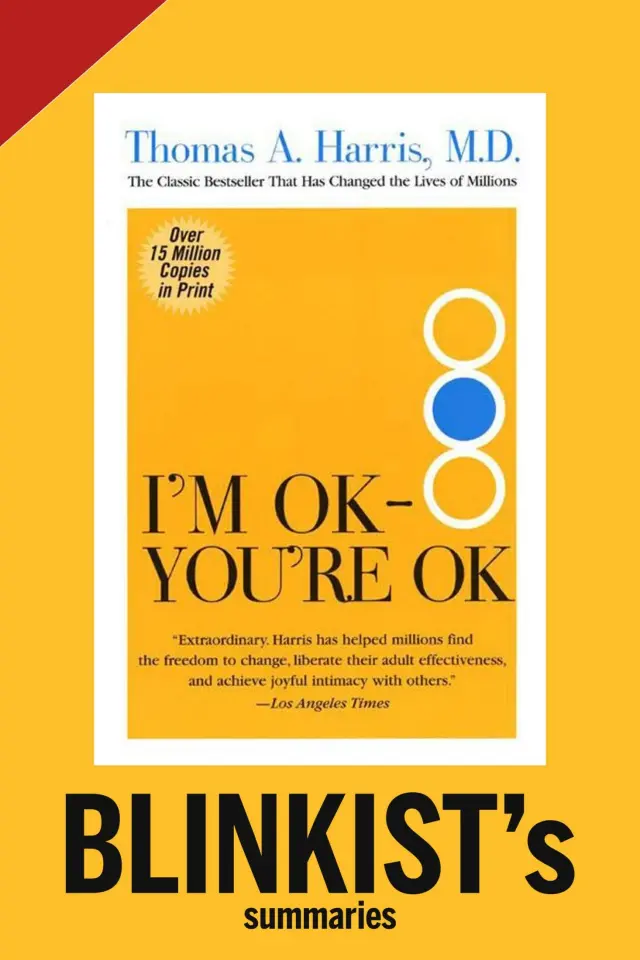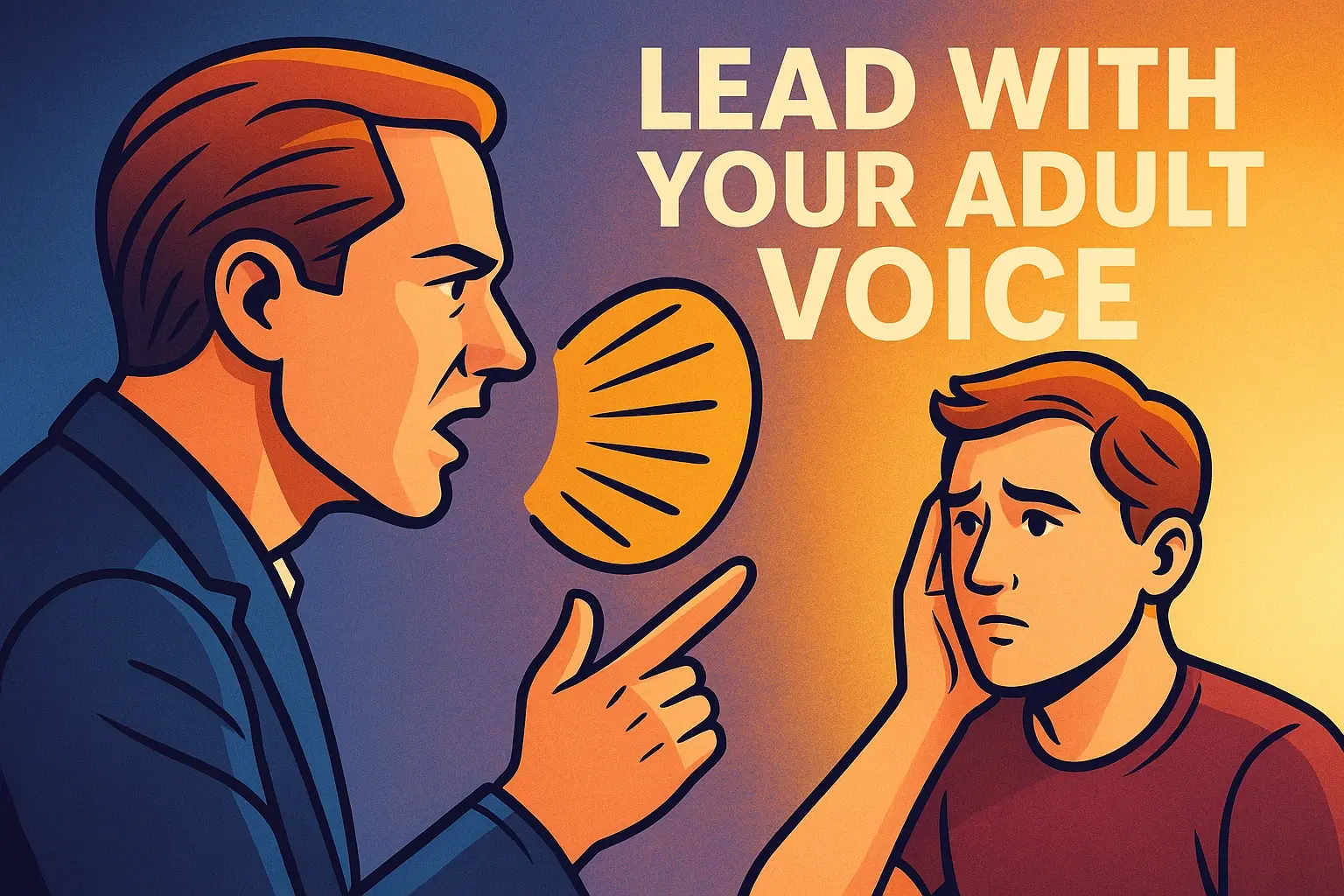
I'm OK, You're OK
By Thomas A. Harris
Published October 2, 2025
Blinkist distills Thomas A. Harris’s transactional analysis classic into a playbook for taming the Parent and Child recordings that hijack adult conversations. By spotting our learned life positions, cataloguing the strokes we trade for validation, and strengthening the present-tense Adult voice, we can rewrite the scripts that keep us stuck in shame or superiority. The summary shows how practical rituals—from journaling to naming ego states in real time—turn “I’m OK, You’re OK” from a slogan into a daily practice that softens relationships and steadies self-worth.
Key Lesson
Name which ego state is in charge and let your Adult choose the next move.
Lead with Your Adult Voice
Book Snapshot
Publisher
Harper & Row
Original Year
1969
ISBN
9780060023850
ASIN
0060724277
Topics & Search Phrases

Full Summary
Thomas A. Harris wrote I'm OK, You're OK at the height of the human potential movement, but the questions that propel the book remain timeless: Why do smart, loving adults suddenly sound like wounded kids? What makes us fall into rigid power struggles with partners, coworkers, or strangers? Harris uses transactional analysis to answer those questions, translating complex psychiatry into everyday language. Blinkist’s summary keeps that spirit alive, walking us through how three ego states—Parent, Adult, and Child—run the conversations inside our heads and the conversations we have with others. The goal is not to banish any one state, but to understand their scripts so we can choose responses that create connection instead of conflict.
The Child state is our emotional archive. It records every sensation experienced when we were small and powerless: the shock of cold air in the delivery room, the panic of seeing a parent’s disapproval, the delight of being praised. Because a baby’s brain lacks adult logic, those impressions get stored as raw feelings—terror, shame, joy—that can be reactivated decades later. Harris shows how those recordings are not just memories; they are like high-fidelity tapes that replay automatically when today’s events resemble yesterday’s wounds. A colleague’s raised eyebrow can send us straight back to a second-grade classroom, heart pounding as a teacher scolds us for fidgeting.
Balancing the Child is the Parent state, a collage of rules and judgments absorbed from caregivers, teachers, and culture. Parent speaks in absolutes: “Always be polite,” “Big boys don’t cry,” “People who look different are dangerous.” Some of these maxims keep us safe, but others calcify into prejudice or perfectionism. When the Parent state dominates, we lecture, nag, or evaluate ourselves and others without mercy. Harris uses case studies to show how unexamined Parent programming fuels systemic issues like racism and sexism—beliefs transmitted across generations because no one pauses to question the source.
Between these two archives sits the Adult state, a cool-headed processor that lives in the present. Adult gathers data, tests assumptions, and decides based on facts rather than fear or inherited rules. In Harris’s framework, emotional maturity is not about suppressing Parent or Child, but about letting Adult run the dashboard. When Adult is online, we can nurture the Child’s creativity and joy while editing the Parent’s outdated commands. Blinkist’s retelling highlights how this balance makes transactional analysis a pragmatic toolkit for everyday life rather than an abstract theory.
Harris introduces the idea of “transactions,” the back-and-forth exchanges that make up communication. Miscommunications happen when we send a message from one ego state but receive a reply from another. Picture a manager (Parent) announcing a policy with rigid authority while an employee responds from Child, feeling shamed and defensive. The conversation spirals because the ego states are crossed. Harris encourages us to diagnose which part of ourselves is speaking and to shift the exchange toward Adult-to-Adult dialogue, where facts and mutual respect drive the outcome. When the manager restates the policy while acknowledging concerns, both parties reengage their Adult state and the conflict eases.
The book’s most famous framework is the set of four “life positions”: I’m Not OK, You’re OK; I’m Not OK, You’re Not OK; I’m OK, You’re Not OK; and the healthy ideal, I’m OK, You’re OK. Early experiences often push children into the first quadrant—they feel vulnerable and inferior while seeing adults as powerful and competent. Some people stay there, seeking approval at any cost. Others rebel and flee to I’m OK, You’re Not OK, using contempt to shield their fragile Child. The worst-case scenario is I’m Not OK, You’re Not OK, a nihilistic stance that fuels despair and, in Harris’s practice, sometimes surfaced in patients with severe depression. The breakthrough insight is that these positions are learned, not destiny. We can reeducate ourselves toward mutual okayness by revisiting the tapes that built our self-concept.
Reeducation starts with awareness. Harris recommends “decontaminating” the Adult state by spotting when Parent or Child assumptions masquerade as facts. Blinkist replays an example of a woman whose Child tape whispered that intimacy always ends in abandonment. Her Adult began testing that belief by comparing it to her present partner’s actual behavior. Keeping a log of gut reactions, tracing them back to their source, and reality-checking them with trusted people are all methods for cleaning up contaminated thinking. The moment we notice a flood of shame or superiority, we can pause, ask which ego state is speaking, and invite Adult to take the mic.
Another concept that remains relevant is the idea of “strokes.” In transactional analysis, strokes are units of recognition—smiles, compliments, scoldings, even silent acknowledgement. Humans crave strokes the way we crave nutrition, and we will accept negative strokes if positive ones are scarce. Harris cautions that many families socialize children to prefer negative strokes (“Stop showing off”) over none at all, inadvertently rewarding destructive behavior. The Adult’s job is to renegotiate our economy of strokes: seek out nourishing feedback, offer it freely to others, and set boundaries when people try to hook us into corrosive exchanges.
Harris also explores life scripts, the unconscious stories we assemble from childhood experiences. One client’s script might be “I must rescue everyone to earn love,” while another’s might be “If I succeed, I’ll betray my family.” These scripts are powerful because they compress years of reinforcement into a simple storyline. Blinkist’s summary emphasizes Harris’s solution: recognize the script, honor the Child who wrote it for survival, and then rewrite it using Adult logic and compassionate parenting of oneself. Techniques like guided imagery, journaling dialogues between the Child and Adult, or working with a therapist can help install a new script where both self and others are allowed to be okay.
Relationships become laboratories for this work. Harris recounts couples who ping-ponged between Parent criticism and Child rebellion until they learned to name the pattern out loud: “My Parent wants to scold you right now; can we both try answering from Adult instead?” In workplaces, teams adopted rituals where meetings opened with a quick check-in of which ego states were present, reducing passive-aggressive clashes. Parents used the model to apologize to their children when they overreacted, modelling what it looks like to shift into Adult and repair. Each story reinforces the idea that transactional analysis is less about perfection and more about rapid recovery—catching the slide into old patterns and choosing a healthier response sooner each time.
Toward the end of the book, Harris offers practical routines to keep the Adult strong. Regular journaling, meditation, and even playful activities can refresh the Child while keeping it from gripping the steering wheel. Seeking mentors who embody the nurturing aspects of the Parent helps replace harsh internal voices with supportive ones. Blinkist underscores that nourishment matters: adequate sleep, mindful breathing, and shared meals can stabilize emotions and make it easier to choose grounded responses. The neuroscience we now know supports Harris’s intuition—self-regulation thrives when the body feels safe.
Finally, Harris returns to the book’s title promise. Saying “I’m OK, You’re OK” is not a naive affirmation; it is a disciplined stance that we practice moment by moment. It means trusting that we have inherent worth while granting the same assumption to others, even when we confront their harmful behavior. The stance demands boundaries—Adult does not allow abuse—but it resists the temptation to degrade ourselves or our counterparts. Blinkist concludes with a challenge: spend the next two weeks tracking the conversations that knock you out of okayness. Each time you notice a Parent sermon or a Child panic, breathe, name it, and invite Adult to choose a response that honors everyone’s dignity. Over time, that practice rewires the default setting of your inner dialogue. The Child feels safe enough to be playful, the Parent becomes a wise guide instead of a tyrant, and the Adult gains confidence. That is the living, breathing definition of “I’m OK, You’re OK.”
See also: How to Be Perfect, I'm OK, You're OK, The Ethical Slut: a Guide to Infinite Sexual Possibilities
Key Takeaways
- Map your Parent, Adult, and Child ego states so you can recognize which voice is speaking before you react.
- Name the life position you default to—victim, rebel, cynic, or mutual okayness—and challenge it with present evidence.
- Decontaminate your Adult by logging emotional triggers, tracing them to childhood tapes, and reality-checking the story.
- Upgrade your ‘stroke economy’ by seeking nourishing feedback, refusing toxic recognition, and offering healthy strokes to others.
- Rewrite limiting life scripts with compassionate self-parenting and new commitments that honor both your needs and boundaries.
- Use real-time dialogue cues—like openly switching to Adult language—to straighten crossed transactions in relationships.
- Sustain the practice with rituals that calm the nervous system, refresh the playful Child, and keep the Adult steady under stress.